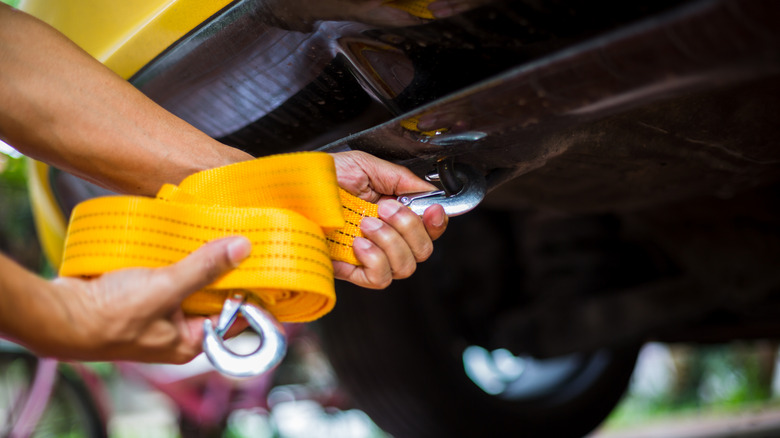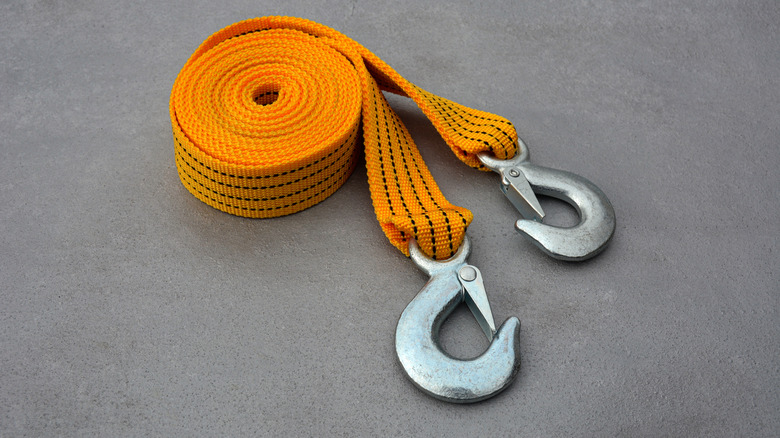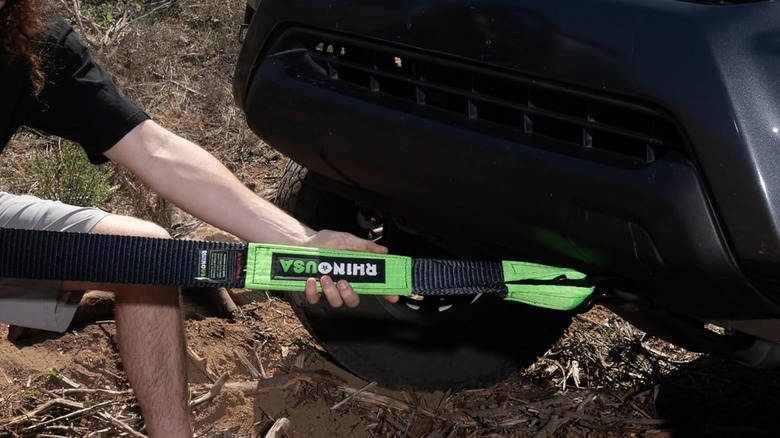Tow Strap Shopping? Here's What You Need To Know Before You Buy
We may receive a commission on purchases made from links.
When you think of a vehicle being towed on the road, you'd probably think of the way a traditional tow truck does it: with a large, suspended hook lifting it up by the front or back and carrying it away. However, that's not the only way to tow a vehicle, and that's good, because it certainly wouldn't be economical to have an entire mechanism installed on something like a personal pickup truck. Another, more economical option for towing is a tow strap, a thick ribbon of sturdy fabric materials like polyester that can be attached to another vehicle for a free-moving tow rather than a lifting hook.
In theory, using a tow strap, with or without hooks, should be as simple as attaching one end to your pickup truck's receiver hitch, and the other end to the mounting hook of the vehicle you're towing. However, while using a tow strap is relatively simple, whether or not you succeed will depend on the precise kind of strap you're using. If you're not using the right kind of strap, you may not be able to safely tow a vehicle, or the strap could snap. The most important factors to be aware of before purchasing a tow strap is the weight capacity and material of the strap in question, as well as whether it's intended for moving or immobile vehicles. There are top-rated car recovery and tow straps available on Amazon, so you'll want to know which is which before paying up.
Keep your vehicle's weight and the strap's towing capacity in mind
Tow straps, generally speaking, are fairly rigid in their construction. They're made of thick, burly materials like polyester or polypropylene, designed to hold fast to their hitches with little-to-no give. As tough as tow straps are, though, they're definitely not indestructible, especially when you remember that we're trying to tow several thousand pounds of metal, glass, and plastic here. If a tow strap's carrying capacity isn't sufficiently high, it won't be able to get a firm grip on a heavy vehicle, or it could snap under the pressure.
The rule of thumb for tow straps is that the strap's total towing capacity should be at least three times that of the vehicle you're hitching it to. The vehicle you're driving, specifically, not the one you're towing. For example, if you were driving a 2024 Ford F-150 Tremor truck, which our own Emme Hall took for a test drive in 2024, you'd have a base weight of about 4,600 pounds with a regular body. For that truck, you would want a tow strap with a capacity of at least 14,000 pounds.
Know the difference between tow straps and recovery straps
A tow strap is designed to tow a free-moving car. That is, a car that can still move on its own wheels if it's pushed or pulled. This is because tow straps are meant to pull vehicles along generally uniform terrain; it's just supposed to be a solid line between your truck and towed vehicle, keeping the latter in line as you drive. Of course, that's not the only scenario you'd need to tow something in, and a typical tow strap may not be sufficient for other kinds of tow jobs. For instance, if there's a completely immobile car stuck in a ditch that needs to be pulled up and out, a tow strap won't be able to handle it due to the lack of elasticity in its materials.
For these kinds of jobs, there exists an offshoot of tow straps known as recovery straps. As the name implies, these straps are designed to yank vehicles out of the lurch and drag them away. Unlike the rigid polyester of tow straps, recovery straps are made of elastic materials like nylon. They're still very strong, but that extra bit of bounce helps the strap to keep its grip without damaging the vehicle you're trying to tow.


